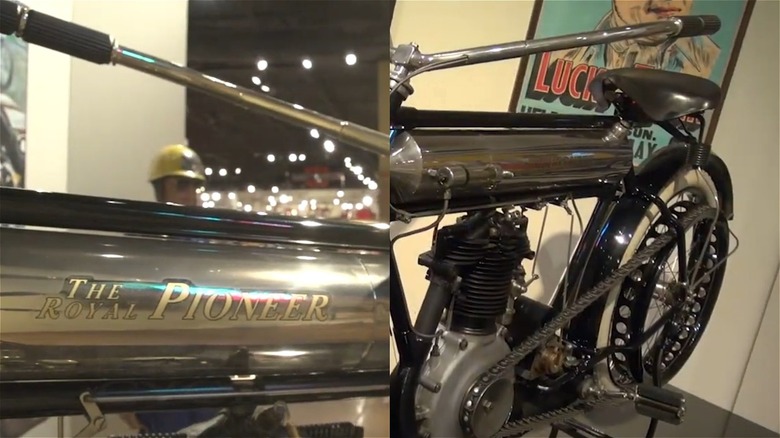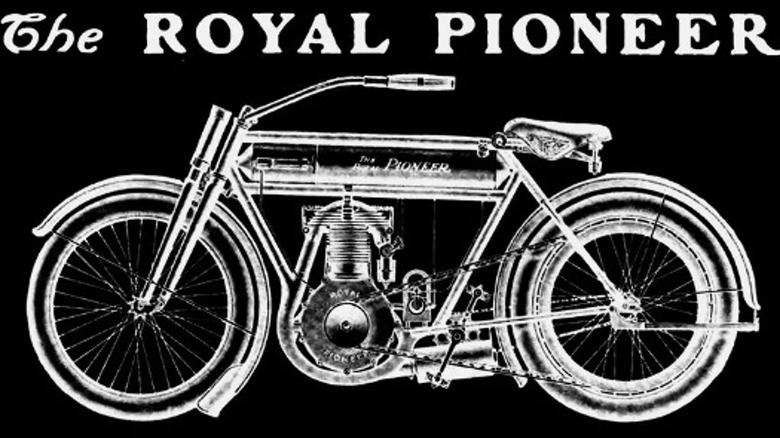The Royal Pioneer Motorcycle Has A Fascinating History Not Many People Are Aware Of
We may receive a commission on purchases made from links.
Royal Motor Works may not be a familiar name to many, although their revolutionary approach to motorcycle design and manufacturing had them on the fast track to becoming legendary. The early 20th century U.S. looked drastically different than it does today, not just in terms of vehicles but also the fact paved roads weren't yet common. In fact, the long and winding history of roads and highways proves to be a compelling study of why modern cities look the way they do. However, in 1909, with the help of the innovative Royal Pioneer motorcycle, the rolling and uneven dirt roads of Worcester, Massachusetts, became easily manageable.
The 500cc one-cylinder (with hemispherical head) Royal Pioneer could reach speeds of up to 60 mph and was completely manufactured locally. Back in those days, motorcycles shared several similar characteristics to bicycles, even including working pedals that could help propulsion. Fortunately, Royal Motor Works developed a clutch for the engine (something absent from other models at the time), which allowed riders to conquer inclines without worry of stalling the engine.
So, with exciting new technology and popularity for the brand growing rapidly, what happened? Unfortunately, tragedy struck and burned the Royal Motor Works empire to the ground, literally. A massive blaze from inside the factory in December 1909 quickly accelerated out of control, decimating not only the Royal Pioneer but the company as a whole.
What made Royal Pioneer special?
There are several aspects of this classic motorcycle that set it apart from other offerings of the time. First, Royal Motor Works took a unique approach to the build process for the 1909 Royal Pioneer by using an in-house designed engine and chassis. This was counter to what was common for the era, where manufacturers utilized outsourced designs with licensed permission from other industry players.
It was also customary for motorcycle builds in the early 1900s to feature components that were made in different regions and operations separated across distinct facilities. Royal Motor Works was one of the rare manufacturers who sourced and built everything locally, keeping the entire process within the city limits of Worcester, although one could argue this philosophy is what made the eventual fire so utterly devastating to the company.
In terms of innovative technology, the Royal Pioneer featured many enhancements, such as an overhead valve pull rod configuration, which allowed the engine to not only breathe better but to use less energy than other systems. This iconic model also incorporated a front fork suspension system using air as the spring. Another major achievement with the Royal Pioneer was that it included a clutch. Many other motorcycles of the time had a direct-drive system, which didn't allow riders to slow (such as when climbing an incline) without stalling the engine. While the Royal Pioneer still lacked gears, it enabled the rider to withdraw from the drive system, eliminating the persistent problem of the engine dying during certain circumstances.
How many Royal Pioneer models were made and what are they worth now?
It's thought-provoking to think about what could have been in terms of Royal Motor Works. After all, the very first Indian motorcycle was purchased in 1902, and the brand is still going strong. How would the industry have changed if the Royal Pioneer was just the first of many remarkable achievements?
The reality of the motorcycle business is that it's a competitive industry. When looking at the motorcycle market share makeup of the US in 2023, Statista.com lists six brands with a statistically significant presence and lumps all the other manufacturers into an Other Brands category together. The challenge of getting your motorcycle brand name out there isn't a modern phenomenon either, as there are several classic motorcycle brands that aren't around anymore due to economic factors or more alluring competitors.
Unfortunately, less than 500 Royal Pioneers were made, and as few as four are still around today, according to Hemmings.com. Being extremely rare and a symbol of a long-lost brand, you likely already know the cost of owning one is staggeringly steep. In 2006, a surviving 1909 Royal Pioneer secured $110,000 at auction, as recorded by GoodingCo.com. Per Cars.Bonhams.com, in 2010, another 1910 Royal Pioneer was sold at auction for $92,000. While this figure is certainly a hefty sum, it's not the highest that classic motorcycles have fetched, such as the story of a 1908 Harley-Davidson strap tank, which set records with its sale price.


